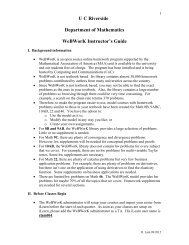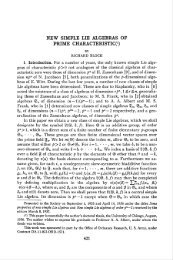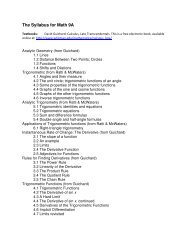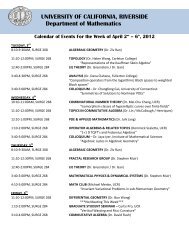Mining Big Data - Department of Mathematics - University of ...
Mining Big Data - Department of Mathematics - University of ...
Mining Big Data - Department of Mathematics - University of ...
You also want an ePaper? Increase the reach of your titles
YUMPU automatically turns print PDFs into web optimized ePapers that Google loves.
immigration in the United States,particularly relating to Asian Americans.The problem with focusing on AsianAmericans: lack <strong>of</strong> data. Ramakrishnan setout to change that.With three colleagues, Ramakrishnanconducted the 2008 National Asian AmericanSurvey, the first study <strong>of</strong> its kind conducted atthe national level. They surveyed more than5,000 Chinese, Indian, Vietnamese, Korean,Filipino and Japanese Americans.The data formed the basis for the 2011book, “Asian American PoliticalParticipation: Emerging Constituents andTheir Political Identities.”The survey and book are importanttools for community advocates, politiciansand policymakers. For example, votermobilization groups such as APIA Vote!have used the survey’s findings to identifythe places and ethnic groups where civicparticipation could use the mostimprovement. Also, the DemocraticNational Committee has focused on thefindings that most Asian Americans stillhave not made up their minds on whichparty to identify with, and is seeking toimprove its outreach efforts.The survey also has generated interestamong organizations serving the AsianAmerican community, and Ramakrishnan israising money from foundations to conductin-depth research on issue preferences in2012. (The 2008 survey focused largely oncivic participation.)Ramakrishnan and his co-authors havealso deposited the data on the Inter-<strong>University</strong> Consortium for Political andSocial Research (ICPSR), a data archive <strong>of</strong>more than 500,000 files <strong>of</strong> research in thesocial sciences that is housed at the<strong>University</strong> <strong>of</strong> Michigan.“In some ways having our data availableat ICPSR is even more rewarding thanpublishing,” Ramakrishnan says. “Byreleasing data so others can access it we arehaving a really big impact.”Meanwhile, Luciana Dar, an assistantpr<strong>of</strong>essor <strong>of</strong> education, is also interested inpolitics, specifically its intersection withhigher education. She focuses on howpolitical dynamics, ideology and politicalinstitutions affect government decisions onhigher education spending, regulation andpolicy.She prepared to conduct that researchby spending about two years in themid-2000s as a graduate student compilinga database <strong>of</strong> information.The database includes information fromall 50 states and spans from 1976 to 2010.It includes more than 50 variables – rangingfrom unemployment to college agepopulation to indicators <strong>of</strong> legislativepartisanship – that she can study.That database forms the basis <strong>of</strong> much<strong>of</strong> her research, which focuses on topicssuch as how best to award financial aid andthe impact <strong>of</strong> state higher educationcentralization/decentralization on the pricestudents pay to go to college.Gaming the MarketIn the business school, Donna H<strong>of</strong>fmanand Tom Novak, marketing pr<strong>of</strong>essors formore than 20 years and co-directors <strong>of</strong> theSloan Center for Internet Retailing at UCR,have focused on social media, online consumerbehavior and digital marketing trends.The biggest change H<strong>of</strong>fman has seen inrecent years has been the availability <strong>of</strong> moresophisticated data that can be used to targetconsumers through a wider range <strong>of</strong> channels.H<strong>of</strong>fman says billboards like those seenin the movie “Minority Report,” in whichJohn Anderton, the character played by TomCruise, is bombarded with personalizedadvertisements as he walks through ashopping mall, are not too far away frombeing a reality. Using wireless technologyand data stored in a person’s cell phone,advertisers could target consumers inreal-time based on their shopping habits.“I think we’re kind <strong>of</strong> entering a bravenew world where retail and Internetknowledge <strong>of</strong> consumers are beingcombined in interesting ways people don’tunderstand yet,” says H<strong>of</strong>fman, who hasbeen a digital marketing consultant withcompanies including Procter & Gamble,Micros<strong>of</strong>t and Walmart.com.With that in mind, H<strong>of</strong>fman and Novakhave started a new line <strong>of</strong> research they arecalling the gamification <strong>of</strong> marketing. It“I think we’re kind<strong>of</strong> entering a bravenew world whereretail and Internetknowledge <strong>of</strong>consumers arebeing combinedin interestingways people don’tunderstand yet.”focused on adding game play elements – suchas Facebook “likes” and being the “mayor”<strong>of</strong> a store on Foursquare – into marketing.“This has the potential to get pretty out<strong>of</strong> control,” H<strong>of</strong>fman says. “Marketers arestarting to treat customers like monkeys.They are dangling large bananas. You walkin a store: ‘Here’s your banana. Now buysomething.’ It’s important to step back andstudy the implications <strong>of</strong> this.”Stock TweetsDonna H<strong>of</strong>fmanUCR marketingpr<strong>of</strong>essorAlso focused on social media, butcoming from a different angle is VagelisHristidis, an associate pr<strong>of</strong>essor <strong>of</strong>computer science and engineering.Hristidis specializes in data mining,which focuses on discovering patterns and/or irregularities in large data sets. The fieldbecame recognized as a major disciplineabout 10 years ago after growing out <strong>of</strong>research in statistics, databases and artificialintelligence.Hristidis and several other researchersrecently developed a model that uses datafrom Twitter to help correlate and predictUCR Spring 2012 | 11







